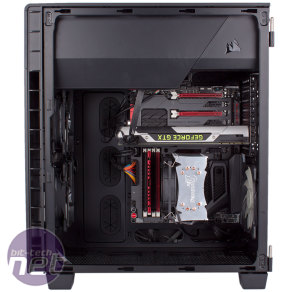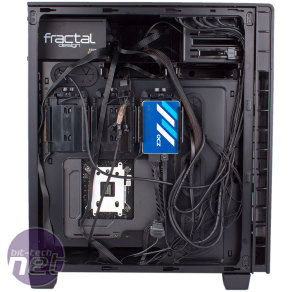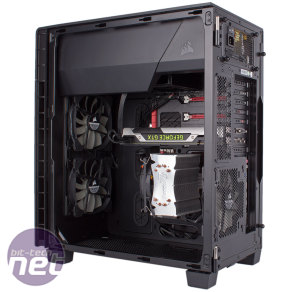
Performance Analysis
The unimpeded airflow path certainly works well for the 600C, and we suspect that it is also helped by its relative lack of depth, as this means air has less distance to cover making the flow of air more effective. With the fans at full speed, both the CPU and GPU are only 1°C warmer than they are on an open test bench, so clearly the components are not struggling to get access to cool air (or to exhaust hot air). The performance is also better than the Be Quiet! Silent Base 600, particularly when it comes to the GPU. This component is more responsive to good intake airflow, which suggests that those large vents down the sides are pretty effective.While there is a low-noise variant of this case available (a sensible move by Corsair that we'd like to see other manufacturers adopt), the 600C is far from a loud case. The fans emit an audible but quiet hum at full speed, and component noise is fairly well contained too – not surprising given the solid front and roof and the general absence of heavily ventilated areas. Dropping down to medium, however, results in noticeably lower noise but an increase in temperature of just 1°C for both the CPU and GPU. This speed setting, as it so often is, is definitely the best balance between noise and performance.
Even at minimum speed, where the case fans are virtually silent, the CPU maintains a very respectable delta T of 56°C. The GPU does warm up by another 2°C, but even then it's still better than the Silent Base 600 at its full speed setting. This isn't particularly surprising as it only has one 140mm intake compared to Corsair's two, and the airflow path isn't as clear. The Silent Base 600 also has more dramatic performance drop offs as you decrease fan speed – Corsair's fans here and the internal design certainly seem to help lessen the impact of lowering the fans' RPMs.
Conclusion
The 600C is a very good chassis and a positive step for Corsair. The highlight is definitely the performance at lower fan speeds – it's possibly the best case we've seen in this regard as even with a powerful graphics card and an overclocked CPU you can quite safely run the fans at their medium and low-speed settings, giving you an appreciable lessening of noise but with minimal impact on the thermal performance. This bodes especially well for the 600Q, although obviously without actually testing that case we can't say for sure how well it will match the 600C's performance.In other areas, the 600C is solid but doesn't overly amaze us given the price tag. The build quality, feature set, cable management and water-cooling support, for example, are all decent, but none are especially outstanding. The Phanteks Enthoo Luxe, for example, comes in at £120 too but includes aluminium on its front and roof panels, internal RGB lighting, superior water-cooling support thanks to dedicated pump and reservoir mounts and also the awesome PWM fan hub. Still, just because the 600C isn't the best value case around doesn't mean it's bad value – you still get a great case overall for your money. If the inverted ATX design works for you, the 600C is easy to recommend for a mid to high-end build, especially if you're particularly keen on striking a great balance between noise and airflow.

-
Cooling24 / 30
-
Features18 / 20
-
Design27 / 30
-
Value15 / 20


MSI MPG Velox 100R Chassis Review
October 14 2021 | 15:04












Want to comment? Please log in.